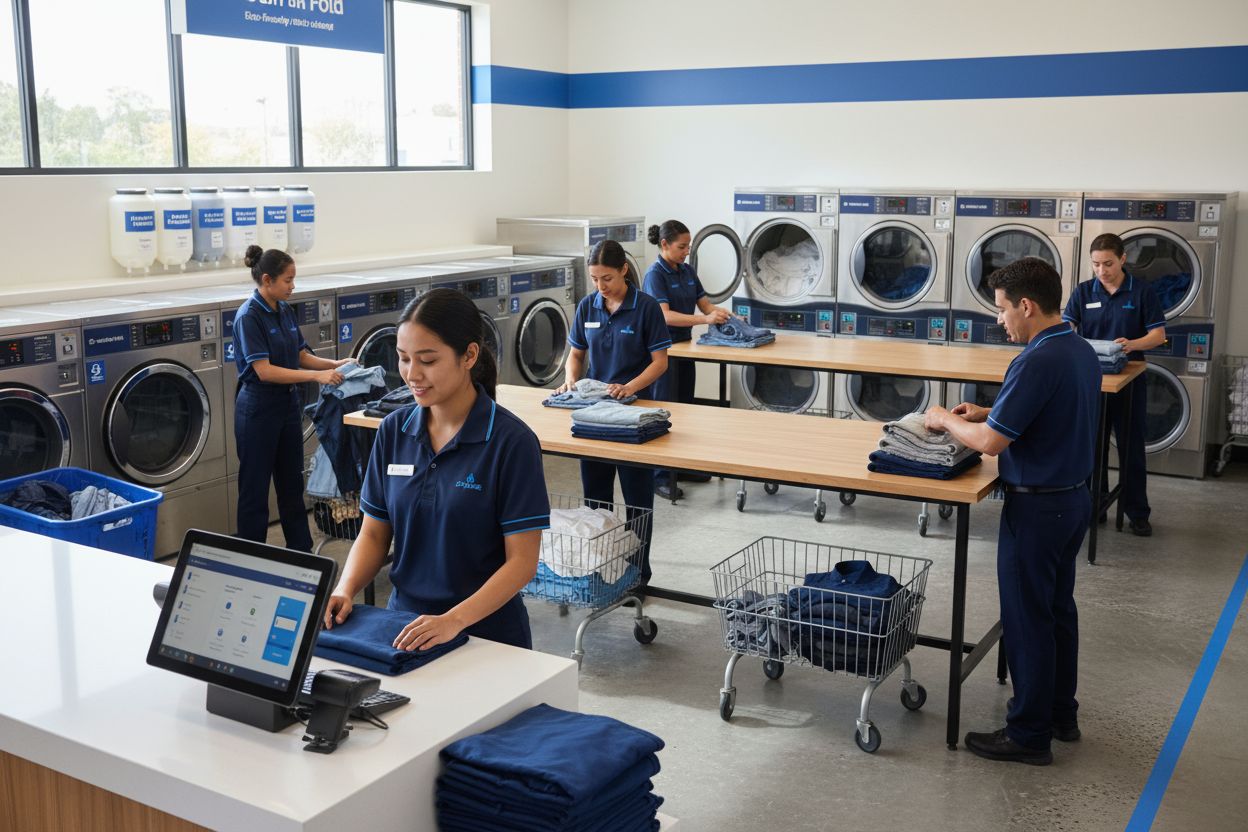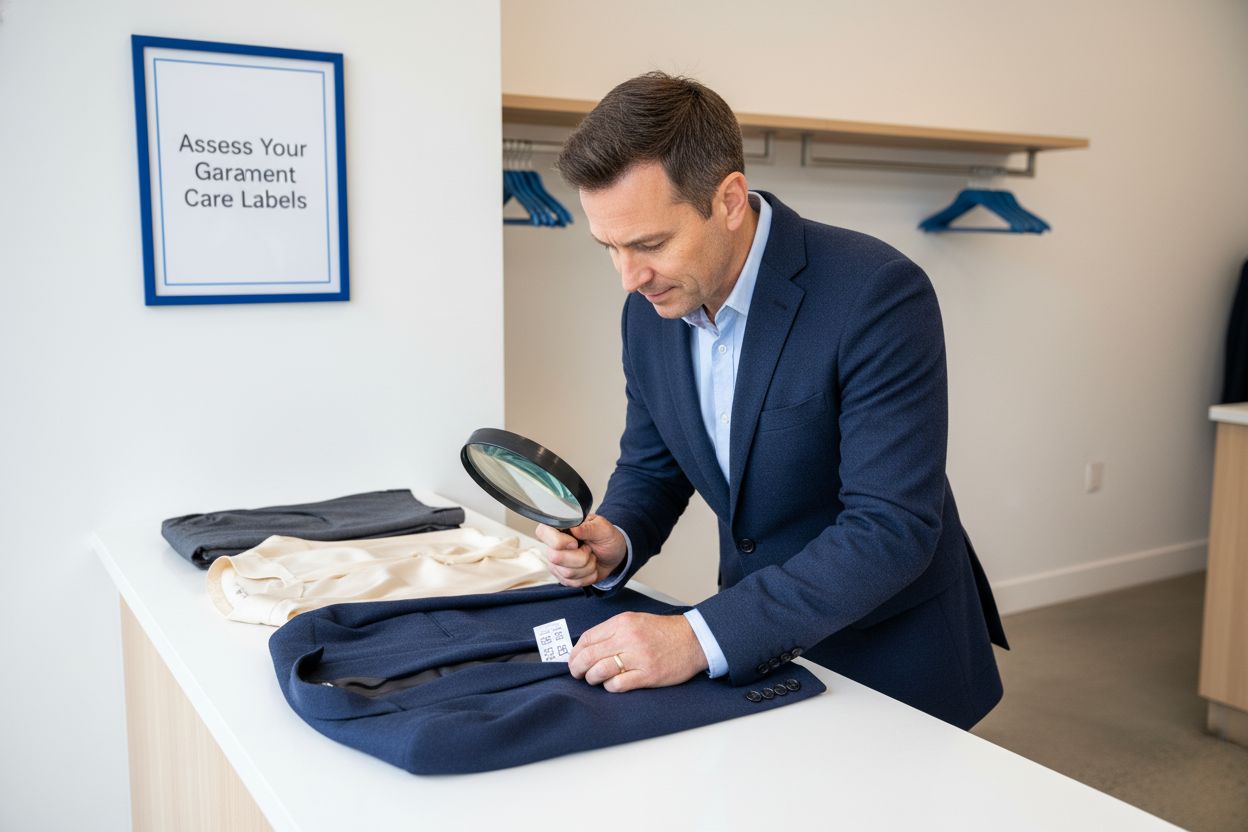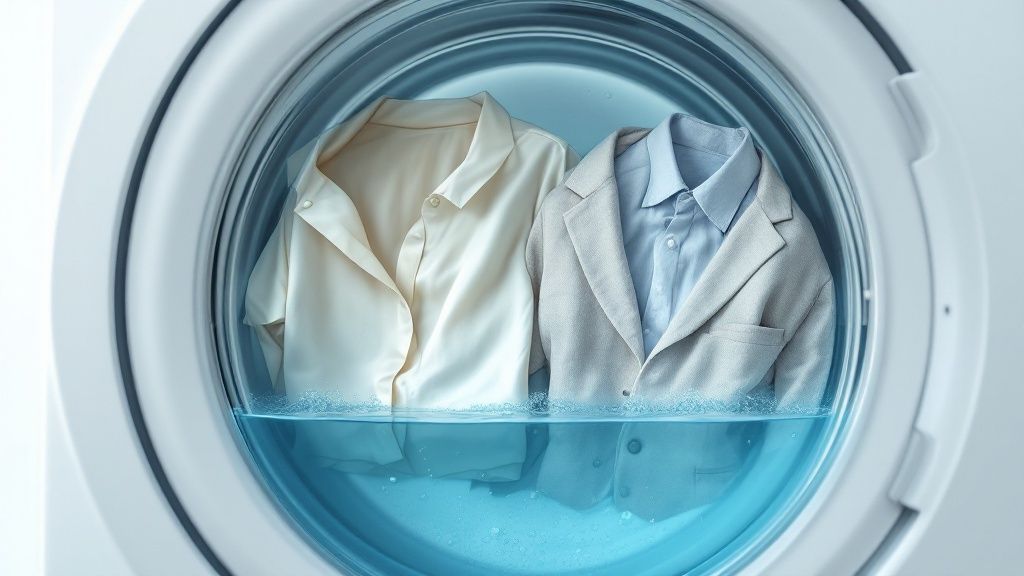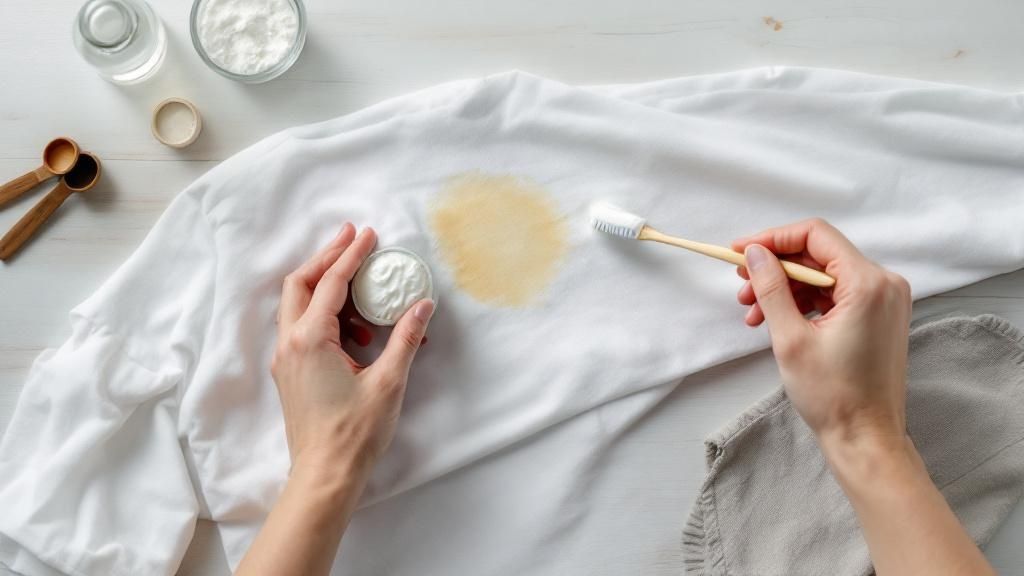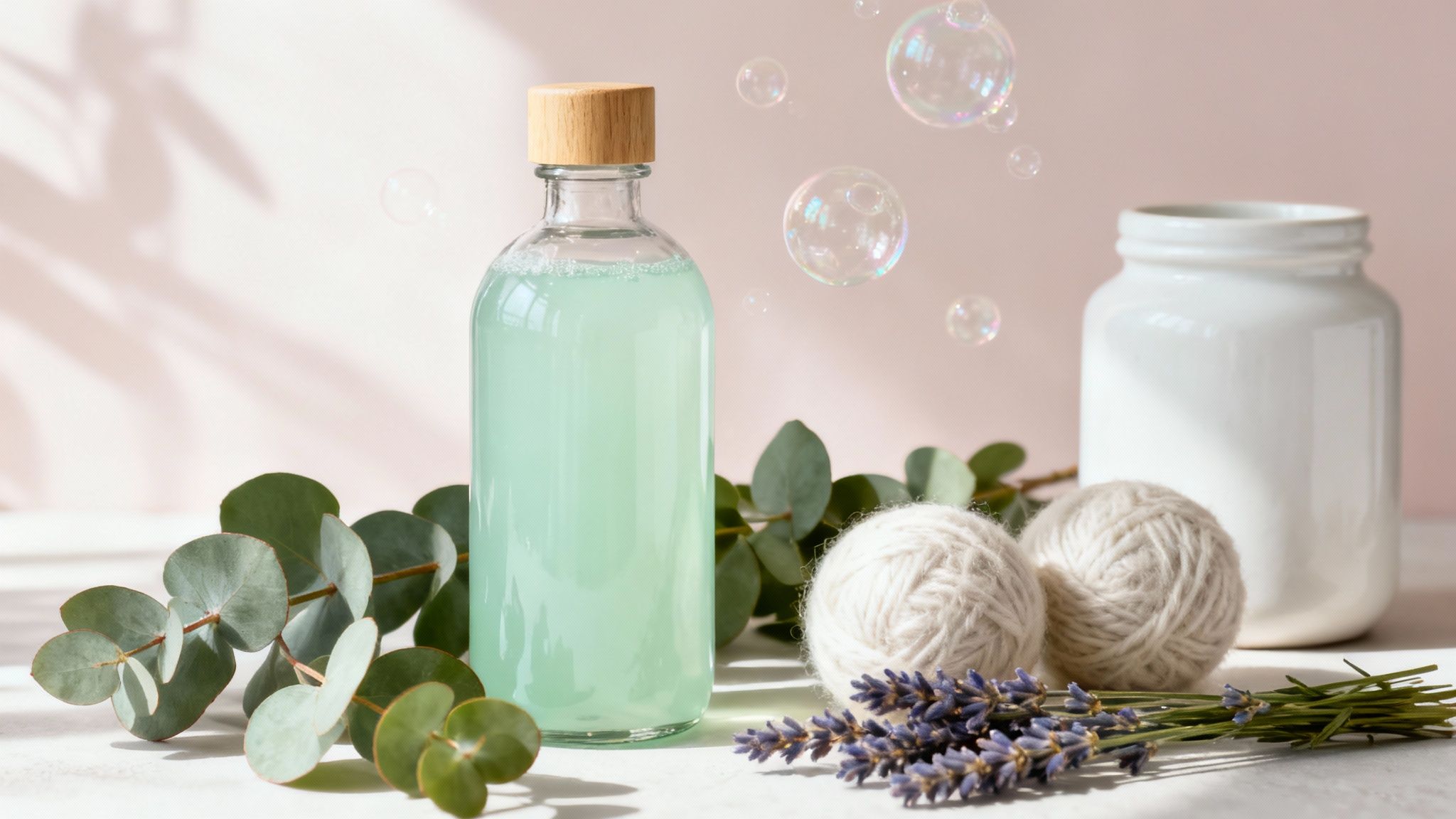Borax for Laundry Stripping A Practical Guide

Ever had that frustrating moment when your freshly washed towels still feel a bit stiff or have a lingering, musty smell? You're not crazy. It's a common problem that happens when regular washing just can't cut through the deep-seated gunk from detergent residue, body oils, and hard water minerals. This is where borax for laundry stripping comes in—it's a seriously effective way to deep clean your fabrics and bring them back to life.
Why Borax Is Such a Big Deal for Laundry Stripping

Think of your laundry, especially those super-absorbent towels and bed sheets, as sponges. Over time, they grab onto and hold all sorts of things that a normal wash cycle simply can’t rinse away. This invisible buildup is the real culprit behind that damp smell or the reason your towels just don't seem to absorb water like they used to.
Laundry stripping is basically giving your fabrics a long, hot soak in a special solution designed to pull out all that stubborn accumulation. And borax is one of the star players in that solution.
Before you dive in, it helps to have all your supplies ready to go. Think of it as your laundry stripping command center.
Your Laundry Stripping Toolkit
Having these items measured out and within arm's reach makes the whole process go a lot smoother.
How Borax Actually Works Its Magic
So what’s the secret? Borax, which is just a naturally occurring mineral compound called sodium borate, has been a go-to laundry booster for over 125 years for a good reason. It’s fantastic at softening hard water, which lets your detergent do its job way more effectively. You can read more about the long history of borax in laundry on borax.com.
When you toss it into your hot water soak, borax raises the water's pH level, making it more alkaline. This little chemistry tweak creates the perfect storm to break down and release all the nasty stuff hiding in your fabrics:
- Detergent and Fabric Softener Film: These products are notorious for leaving behind waxy residues that build up over time.
- Hard Water Minerals: Things like calcium and magnesium cling to fibers, making them feel stiff and look dingy.
- Body Oils and Sweat: These get trapped deep in the weave of the fabric, causing those stubborn, persistent odors.
The best part? Seeing that satisfyingly murky, gray water after a few hours of soaking. It's the gross-but-gratifying visual proof of all the buildup that was hiding in your supposedly "clean" laundry.
Ultimately, using borax for laundry stripping is more than just cleaning—it's about hitting the reset button on your textiles. It genuinely restores that original softness and absorbency, making old towels and sheets feel almost new again.
The Complete Borax Laundry Stripping Method

Alright, now for the fun part—getting to see all that gunk come out of your "clean" laundry. The process itself is straightforward, but you'll need a little patience.
I've found the bathtub is the perfect place for this, but a big utility sink or even a top-loading washer will do the trick. The most important thing is to start with the hottest water your tap can possibly produce. That heat is what helps open up the fabric fibers to release all the trapped buildup.
As the tub is filling, go ahead and create your stripping concoction. Just sprinkle the ingredients directly into the hot water: about a quarter cup of borax, a quarter cup of washing soda, and a half cup of your favorite powdered laundry detergent. I like to use a long-handled spoon to give it a good stir until everything is completely dissolved.
The Soaking Process
Once your water is ready, start adding your clothes or linens. Make sure you fully submerge each piece so it's totally saturated. If you're stripping towels that just don't feel absorbent anymore, you'll probably have to push them down a few times until they stop trying to float. You want the stripping solution to have maximum contact with every inch of fabric.
Now, we wait. The magic happens while your laundry soaks in this hot water solution for 4 to 5 hours. This long soak is what pulls out all the accumulated oils, hard water minerals, and detergent residue that regular washing just can't tackle.
I'd recommend giving everything a stir with a broom handle or a big spoon every hour or so. It just helps agitate things and knock more of that buildup loose.
Don't panic when you see the color of the water! That murky, gray-brown soup is actually a great sign. It's visible proof that the process is working, pulling all that hidden gunk out of your fabrics.
Finishing and Final Rinsing
After a few hours, drain all that dirty water. Gently wring out each item as you take it out of the tub—this will save you from sloshing a gallon of grimy water all over your floor on the way to the washer.
Toss the whole load into your washing machine. I always run a rinse-only or a drain-and-spin cycle first to get rid of most of the dirty water before the actual wash.
Next, run a normal wash cycle on cool without any detergent. And whatever you do, do not add any fabric softener! You just worked hard to strip all that residue out; the last thing you want to do is coat your fabrics in it again.
If you're dealing with really stubborn, old buildup, our guide on how to get detergent stains out of clothes has some extra tips.
Finally, just dry everything like you normally would. You'll be amazed at how much softer, cleaner, and more absorbent your laundry feels.
What You Should—and Should Not—Laundry Strip
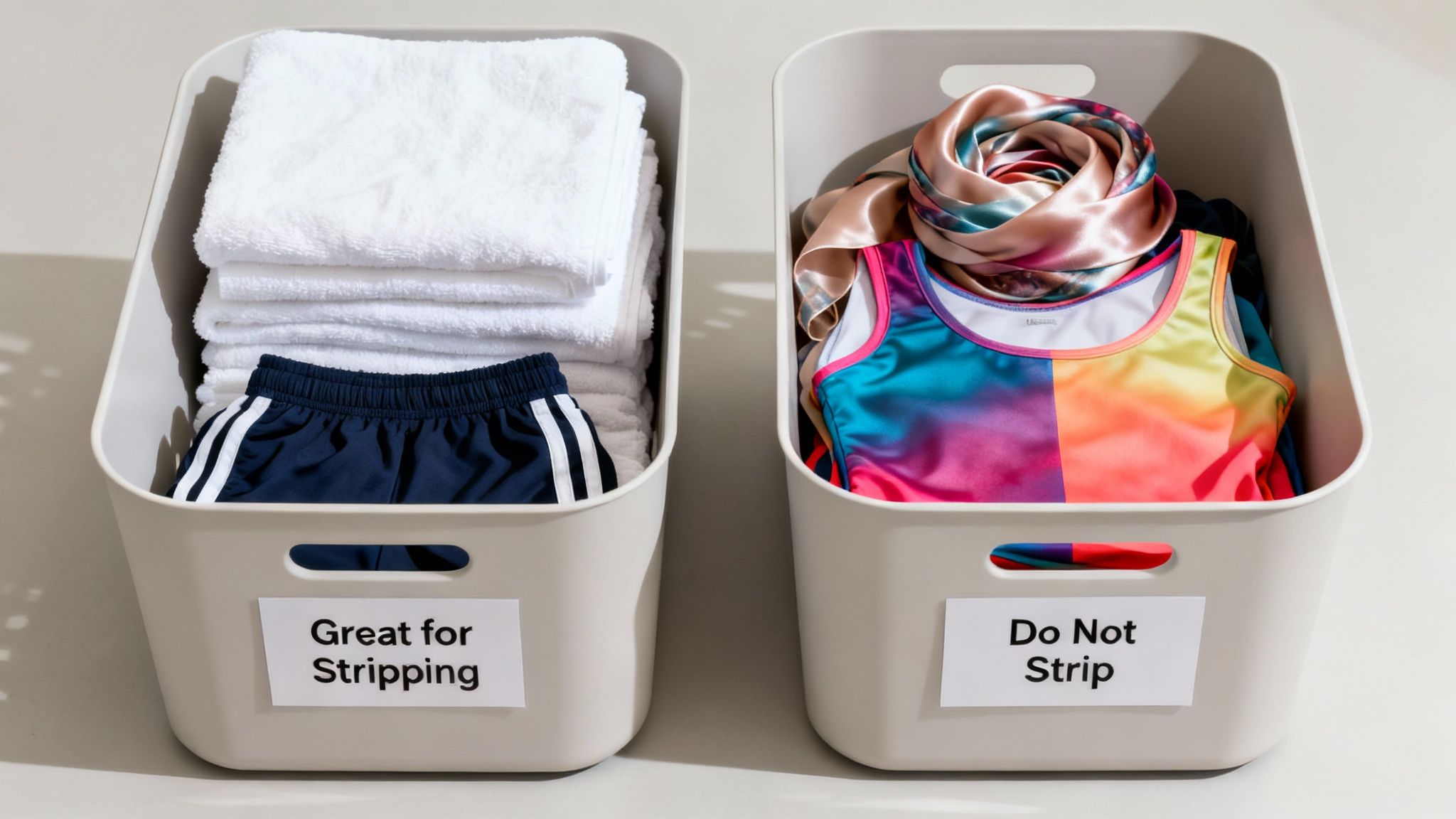
Before you run off and start stripping everything in your linen closet, let's pump the brakes for a second. It's crucial to know which fabrics can actually handle this kind of intense deep-cleaning.
While using borax for laundry stripping is incredibly effective, the combination of super hot water and a high-alkaline solution isn't right for every item you own. Think of it like this: durable, light-colored, and absorbent items are your prime candidates. They’re tough enough to withstand the long, hot soak without getting damaged.
Ideal Candidates for Stripping
These are the items that tend to give you the most satisfying—and, let's be honest, often shocking—results:
- White or light-colored towels: These are notorious for trapping body oils and mineral deposits, which is what leads to that stiff feeling and musty smell.
- Bed sheets and pillowcases: This is especially true for whites and light grays, which can start to yellow over time from sweat and skin oils.
- Sturdy workout clothes: Stripping can be a total game-changer for synthetic gym wear that seems to hold onto odors no matter what you do.
- Kitchen cloths and rags: This process is perfect for cutting through grease buildup and getting rid of those lingering food smells.
The best items for stripping are typically made of cotton or durable polyester blends. They can handle the heat and the chemistry of the stripping solution, emerging softer and truly, deeply clean.
Fabrics to Avoid Stripping
On the flip side, some materials should never, ever be stripped. The process can cause irreversible damage like shrinkage, color fading, or just completely breaking down the fabric.
Definitely steer clear of stripping these items:
- Delicate fabrics: Anything made of silk, lace, or wool is a hard no. The hot water will likely ruin them, causing them to shrink and lose their shape.
- Spandex or elastane: Athletic wear that has a lot of stretch can lose its elasticity and become brittle after a stripping session.
- Vibrantly colored items: Deep reds, dark blues, and blacks are at a high risk of bleeding color. This can ruin the entire load and leave your favorite shirt looking faded and patchy.
For targeted issues on these more sensitive fabrics, understanding how stain removers work for specific stain types is a much safer and more effective approach.
If you're on the fence about a colored item, my advice is to test a single, less important piece first. See how it fares before you commit the whole load.
Smart Safety Tips for Laundry Stripping
When you’re working with powders like borax and washing soda, safety is straightforward, but a few simple precautions can make the whole process completely worry-free. You’re dealing with very hot water and some alkaline ingredients, so the number one rule is to protect your skin.
Always, always pull on a pair of household gloves when you're mixing the solution and handling the wet laundry. This simple step prevents any potential irritation, which is especially important if you have sensitive skin.
Good ventilation is another key. If you're doing this in a small bathroom, just crack a window or flip on the exhaust fan. This helps keep you from inhaling any of the fine dust from the powders as you pour them. It’s a small thing, but it makes a difference.
You also want to think about creating a safe zone, especially if you have curious kids or pets running around. A bathtub full of hot, murky water can look like a fascinating new plaything to them.
The easiest way to handle this? Keep the bathroom door securely closed for the entire 4-5 hour soak. This simple barrier is the most effective way to prevent accidents and give you peace of mind while the stripping solution does its thing.
Best Practices for Better Results
Beyond the basics of keeping things safe, a couple of my favorite pro-tips will help you get the absolute best results from your laundry stripping efforts.
First, resist the urge to overstuff the tub. I know it's tempting to get it all done in one go, but your clothes need room to move around. When they can float freely, the hot water and borax solution can get deep into every single fiber.
Second, that final rinse cycle in your washing machine? Don't skip it. It's a non-negotiable final step that makes sure every last bit of loosened gunk—and the stripping solution itself—is completely washed away. What you're left with is nothing but truly clean, soft, residue-free fabric.
Common Laundry Stripping Issues and Fixes
Even with the best prep, sometimes things don't go exactly as planned. I've put together this quick-reference table to help you anticipate and troubleshoot some of the common hiccups people run into when laundry stripping for the first time.
Think of this table as your go-to guide for a successful strip every time. A little know-how upfront can save you a lot of headaches later and ensure your fabrics come out looking and feeling fantastic.
Borax Alternatives for Natural Laundry Stripping

If you're not keen on using borax or just want to see what you can do with common household staples, you’ve got some great options. Stripping your laundry doesn't always require a special trip to the store for a specific ingredient; some surprisingly effective alternatives are probably already in your pantry.
Lots of people are looking for greener, gentler ways to deep-clean their fabrics these days, and for good reason. Simple, food-grade ingredients like baking soda and vinegar have become the heroes of the natural cleaning world. You can find more details about these developments in non-toxic laundry stripping.
Creating a Borax-Free Stripping Soak
For a simple but mighty borax-free soak, your best bet is to pair washing soda with either baking soda or distilled white vinegar.
- Baking Soda & Washing Soda: This is a classic duo for a reason. Together, they soften water and are fantastic at knocking out stubborn odors. Just use equal parts—about ½ cup of each—and dissolve them in a tub of hot water.
- Vinegar & Washing Soda: Vinegar is a powerhouse for dissolving the mineral buildup that comes from hard water. For this mix, dissolve ¼ cup of washing soda first, and then add 1 cup of vinegar to the soak.
Important Tip: Whatever you do, don't mix vinegar directly with baking soda or washing soda when you're making your stripping bath. That fizzy reaction you see actually cancels out their cleaning power, so you'll just be wasting your ingredients.
Of course, the best strategy is to prevent buildup in the first place. Cutting back on detergent and saying goodbye to fabric softeners can make a huge difference, meaning you won't have to strip your laundry as often. For more ideas on this, check out our guide on how to wash clothes without detergent.
Common Questions About Laundry Stripping with Borax
Even with a solid plan, it's totally normal to have a few questions before you commit to turning your bathtub into a laundry-soaking zone. Let's walk through some of the most common things I get asked about using borax for stripping, so you can get started with confidence.
How Often Should I Strip My Laundry?
One of the biggest questions is about frequency. Think of laundry stripping as a deep-cleaning reset, not a regular part of your weekly routine. For most things, like towels and bed sheets, stripping them two to four times per year is more than enough.
Doing it too often can be hard on the fabric fibers, so it's best to treat it like a seasonal refresh.
Will This Wear Out My Clothes Faster?
Another common concern is whether this intense process will damage fabrics. When you stick to durable materials and don't overdo it, stripping shouldn't cause any premature wear and tear.
The real risk comes from trying to strip delicate items or, as I mentioned, doing it too frequently. Stick with sturdy cottons and synthetics, and your laundry will come out rejuvenated, not ruined.
Can I Strip Laundry in My HE Washer?
This is a tricky one, and the short answer is usually no. Most front-loading, high-efficiency (HE) washers just aren't built for the long, deep soak that stripping requires. They're designed to use very little water, and their doors lock automatically, which makes a multi-hour soak pretty much impossible.
Your best bet is the bathtub, a large utility sink, or a top-loading washing machine that lets you pause the cycle indefinitely to let things soak. I wouldn't recommend even trying this in a front-loader.
Finally, people often wonder what else borax is good for. It's so much more than just a laundry booster! Beyond its key role in stripping, borax is a powerhouse cleaner. You can dive into all the other versatile uses for household borax and see just how handy it is for general cleaning and deodorizing around the house. It's a true multi-purpose tool for your cleaning arsenal.
Tired of spending your weekends on laundry chores? At Columbia Pike Laundry, we believe your time is better spent on things you love. Let us handle the washing, drying, and folding so you can reclaim your weekend. Schedule your first pickup and experience the relief of a laundry-free life. Visit us at https://columbiapikelaundry.com to get started.
Popular Blog Articles

Meet the Author
Daniel Logan didn’t start CPL because he loved laundry. He started it because his family was drowning in time debt, and laundry was one of the biggest weights.
Mornings were chaos with two kids under 5. Evenings felt like catch-up. And weekends? Gone to sorting socks and folding piles.
He knew his story wasn’t unique. So he built a business that gave families like his just a little bit of breathing room one load at a time.
With no laundry experience but deep tech skills, Daniel rolled up his sleeves, doing every job himself while building systems that turned it into a modern laundry service that saves customers time, simplifies their lives, and delivers reliability they can count on.
That’s where CPL began. Not from a playbook, but from pain. From one dad trying to buy back time: for himself, and for every household like his.

